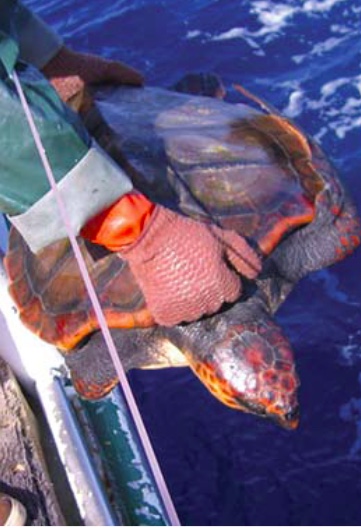
Last year, the number of longline sets targeting swordfish hit a record low of 300, according to Russell Ito of the Pacific Islands Fisheries Science Center. Only 14 of the 150 longline vessels fishing around Hawai‘i last year were shallow-set vessels, he said, and even those later switched their gear to target bigeye tuna, which is what the rest of the fleet does.
One of the main reasons for such little interest in the swordfish fishery is the threat of closure due to interactions with endangered leatherback or loggerhead sea turtles. The fishery is currently limited by a court order to catch no more than 17 loggerheads or 26 leatherbacks in a given year. Within the first month of fishing this year, the shallow-set fleet hooked 12 loggerheads.
“Sea turtle interactions this year ramped up really quickly. I thought it was going to close early, but they’re still under the limit,” Ito said at the council’s March meeting. Even so, he added that there isn’t much interest in catching swordfish under the threat of a fishery closure. “No one wants to gear up and incur those expenses,” he said.
Instead, those former swordfish vessels have contributed to the increase in bigeye tuna fishing effort, which sets far more hooks in the water per set.
Eric Kingma of the Hawai‘i Longline Association said it costs between $10,000 and $15,000 to switch from shallow-set to deep-set gear and takes seven to ten days at the harbor to accomplish. “It is a substantial cost to go back and forth,” he said.
A new biological opinion and incidental take statement on the shallow-set fishery’s impacts on the turtles, issued by the National Marine Fisheries Service last year, proposes relaxing the fishery-wide cap on loggerheads, while restricting even further the allowable takes of leatherbacks. The agency also proposes new trip and vessel limits to restrict the activities of problematic vessels, rather than the entire fishery.
The council and fishery representatives have chafed at the proposed new measures, pointing to the service’s own scientists, who have determined that the fishery has a negligible impact on the survival of either species.
However, those same scientists have pointed out that the turtles face a gantlet of gill-net and foreign fisheries, threats to nesting beaches, and feminization due to rising temperatures, which could ultimately lead turtle populations to crash.
“There are many things we have to consider,” NMFS Pacific Islands Regional Office administrator Mike Tosatto told the council. He did, however, assure the council that his agency would consider the modeling results on the impact Hawai‘i longline fisheries have on the turtles in its upcoming biological opinion for the deep-set longline fishery.
The council voted later to direct its staff to work with NMFS on obtaining publicly available data on sea turtle interaction rates in foreign fisheries operating in areas overlapping loggerhead and leatherback distributions, and to provide the Scientific and Statistical Committee (SSC) with a presentation on that work at the next council meeting in June.
It also recommended that NMFS include a social scientist and an industry representative on its working group regarding turtle protection measures (known as reasonable and prudent measures) for the shallow-set fishery. The council’s SSC determined last month that the measures NMFS has proposed are not reasonable.
— Teresa Dawson

Leave a Reply